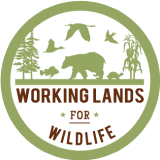-
 Bog Turtle Map
Bog Turtle Map
-
by
Web Editor
—
published
Jul 07, 2019
—
last modified
Sep 27, 2024 02:00 PM
—
filed under:
Bog Turtle Maps,
Apps, Maps, & Data,
Maps and Data,
Resources,
Aquatics
WLFW Bog Turtle Focal Area
Located in
Bog-Turtle-site-images
-
Brook Trout Conservation Portfolio and Range-wide Assessment
-
by
Tab Manager
—
published
Apr 10, 2024
—
last modified
Apr 21, 2025 06:26 PM
—
filed under:
Brook Trout,
Maps and Data,
WLFW
Interactive webmap and visualization tools.
Located in
Learning & Tech Transfer
/
Apps, Maps, & Data
-
Brook Trout Thermal Habitat Forecasts Catoctin Mountain Park, Maryland & Shenandoah Valley, Virginia
-
by
Tab Manager
—
published
Apr 11, 2024
—
last modified
Apr 21, 2025 06:26 PM
—
filed under:
Brook Trout,
Maps and Data,
WLFW
Users can zoom-in to an area of interest and then compare current conditions against various future scenarios (3 levels of air temperature change x 3 levels of GW sensitivity to air temperature change). The interpretation is simple: red sites are too warm (MWAT > 23 C) and blue sites have suitable temperatures.
Located in
Learning & Tech Transfer
/
Apps, Maps, & Data
-
Cave and Karst Biota Modeling in the Appalachian LCC- Observed Amphipods in 20km grid cells
-
by
Tab Manager
—
published
Jun 29, 2016
—
last modified
May 14, 2025 12:20 AM
—
filed under:
Apps, Maps, & Data,
Maps and Data,
Maps and Spatial Data
We developed spatial summary (GIS) layers for a study of factors influencing the distribution of cave and karst associated fauna within the Appalachian Landscape Conservation Cooperative region, one of 22 public-private partnerships established by the United States Fish and Wildlife Service to aid in developing landscape scale solutions to conservation problems (https://lccnetwork.org/lcc/appalachian).
Located in
Apps, Maps, & Data
-
Chesapeake Fish Passage Prioritization Tool
-
by
Tab Manager
—
published
Apr 10, 2024
—
last modified
Apr 21, 2025 06:27 PM
—
filed under:
The Nature Conservancy,
Maps and Data,
WLFW,
TNC,
Maps
This tool evaluates and prioritizes dams and other in-stream barriers to aquatic organism passage to help inform aquatic connectivity restoration projects in the Chesapeake Bay watershed.
Located in
Learning & Tech Transfer
/
Apps, Maps, & Data
-
Coastal Resilience Maine
-
by
Tab Manager
—
published
Apr 10, 2024
—
last modified
Apr 21, 2025 06:27 PM
—
filed under:
Maps,
Maps and Data,
WLFW,
Coastal Resiliency
Allows users to explore barriers to aquatic connectivity — dams and road-stream crossings– and identify likely high priorities for removal or improved fish passage for different objectives as well as to run custom analyses.
Located in
Learning & Tech Transfer
/
Apps, Maps, & Data
-
 Distribution of the American Black Duck
Distribution of the American Black Duck
-
by
Web Editor
—
published
Aug 16, 2019
—
last modified
Apr 18, 2024 04:23 PM
—
filed under:
Maps and Data,
American Black Duck Maps,
Additional Resources,
Apps, Maps, & Data,
Aquatics
Distribution of the American Black Duck. This species breeds locally South to the dashed line.
Located in
Black-Duck-site-images
-
EDDMapS: Early Detection and Distribution Mapping System
-
by
Admin
—
published
Jun 22, 2021
—
last modified
Apr 21, 2025 06:28 PM
—
filed under:
Wildlife,
Maps and Data,
Spatial Data,
Pests,
Exotic Species,
Exotic Species Removal,
Data and Maps,
WLFW,
Distribution
EDDMapS is a web-based mapping system for documenting invasive species and pest distribution. It is fast, easy to use, and doesn't require GIS experience. Launched in 2005 by the Center for Invasive Species and Ecosystem Health at the University of Georgia, it was originally designed as a tool for state Exotic Pest Plant Councils to develop more complete distribution data of invasive species. Since then, the program has expanded to include the entire US and Canada as well as to document certain native pest species. EDDMapS' goal is to maximize the effectiveness and accessibility of the immense numbers of invasive species and pest observations recorded each year. As of June 2021, EDDMapS has over 5.2 million records.
Located in
Apps, Maps, & Data
-
Fish Habitat Decision Support Tool
-
by
Tab Manager
—
published
Apr 11, 2024
—
last modified
Apr 21, 2025 06:26 PM
—
filed under:
2013 Accomplishment Report,
Maps and Data,
WLFW
This tool was created to provide resource managers and the general public with access to the extensive spatial data and results produced from multiple fish habitat assessments. Three main analytical tools (visualization, ranking, and futuring) are combined with intuitive base-maps and mapping features to allow users to explore the details of the assessments and perform subsequent analyses.
Located in
Learning & Tech Transfer
/
Apps, Maps, & Data
-
Freshwater Network Northeast Region: Northeast Aquatic Connectivity Project's Tool
-
by
Tab Manager
—
published
Apr 10, 2024
—
last modified
Apr 21, 2025 06:27 PM
—
filed under:
The Nature Conservancy,
Maps and Data,
WLFW,
TNC,
Maps
Tool for assessing barriers to aquatic connectivity including dams and road-stream crossings.
Located in
Learning & Tech Transfer
/
Apps, Maps, & Data


